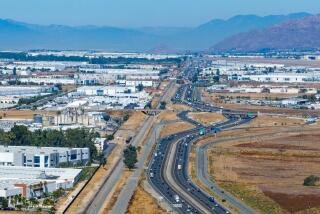Wider Look at Newhall Ranch
- Share via
The largest housing tract ever proposed for Los Angeles County comes before the Board of Supervisors today for the first of many public hearings. With 24,000 homes and a large commercial district, Newhall Ranch--sandwiched between Santa Clarita and the Ventura County line--would house 70,000 people when fully built 25 years from now. It at once embodies much of what’s right in modern urban planning and much of what’s wrong as it so often is practiced in Southern California.
Ultimately, supervisors should approve the project--but not as it stands today. Nor should the board’s voice be the only one heard regarding a development that would directly affect Ventura County and the city of Santa Clarita. Bottom line: Newhall Ranch should be cut in size by 20% to 25% and the scissors should be held jointly by Santa Clarita and Los Angeles and Ventura counties.
By itself, Newhall Ranch is a model of modern planning. The range of its home prices would attract families of various incomes, and developer Newhall Land & Farming would set aside nine square miles of open space and five school sites.
The company’s success in neighboring Valencia illustrates its dedication to quality development. And having a single landowner develop a large parcel gives local authorities more power to extract public goodies like parks and school sites than if the land were carved up among scores of smaller developers.
But the location is a problem. The development would sit in a flood plain and its traffic would jam both the Golden State Freeway and California 126. Santa Clarita and Ventura County rightly believe they deserve a say in the project because many of the negative effects would hit them. It’s a legitimate fear, and handing over some control to them would address that apprehension.
Los Angeles County should remain the lead agency, but land-use laws would permit Ventura and Santa Clarita to be named so-called responsible agencies, giving them a part in the approval process. The arrangement would require good-faith efforts by all parties, and Ventura and Santa Clarita could not unreasonably withhold approval.
If it worked, the process would defy the trend in land planning of sticking it to the neighbors, as Ventura County tried to do to Los Angeles with the huge Ahmanson Ranch development six years ago. That project spent five years in court. A cooperative approach might delay Newhall Ranch now, but that delay would be nothing compared to the one that would await it in the courts.
The need for new housing is real. Southern California is growing fast and the expansion promises to continue. But that growth demands a regional approach. Newhall Ranch could be a start.
More to Read
Sign up for Essential California
The most important California stories and recommendations in your inbox every morning.
You may occasionally receive promotional content from the Los Angeles Times.













